52 weeks. 52 different writers. 2 trade paperbacks or hardcovers a week. Each week I’ll take a look at a different writer and read two different collected editions from within that person’s repertoire to help in the examination of their work.
Longtime DC writer James Robinson is perhaps best known for his work on the series Starman. I admit that I feel like a complete idiot for not reviewing his time with the character for this week as it really does feel like a missed opportunity. Maybe I’ll do a special post on it down the road at some point because it is excellent stuff. Anyways, Robinson is well known for his work with Golden Age DC characters, whether they be characters like Starman or even the Justice Society Of America. When the New 52 relaunch happened over at DC Comics back in 2011, James Robinson was given the reigns for the Earth 2 reboot which saw the modernizing of several of the Golden Age DC superheroes for this new take on Earth 2.
Earth 2 Vol 1: The Gathering
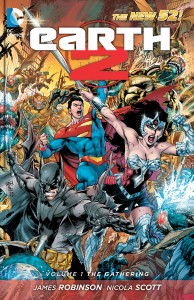 As the evil hordes of Apokolips assault Earth, the “Trinity” of Batman, Superman, and Wonder Woman fight valiantly to protect their world. Steppenwolf seeks to use the forces of Apokolips to conquer the Earth as several of its mightiest heroes come together to protect it. The “Trinity” falls during the battle but manages to defeat the forces, leaving Earth devastated but still intact. Five years later, a new breed of these “wonders” begin to pop up all over the world as new threats begin to emerge and threaten the safety of Earth once again.
As the evil hordes of Apokolips assault Earth, the “Trinity” of Batman, Superman, and Wonder Woman fight valiantly to protect their world. Steppenwolf seeks to use the forces of Apokolips to conquer the Earth as several of its mightiest heroes come together to protect it. The “Trinity” falls during the battle but manages to defeat the forces, leaving Earth devastated but still intact. Five years later, a new breed of these “wonders” begin to pop up all over the world as new threats begin to emerge and threaten the safety of Earth once again.
James Robinson gives us a whole new take on Earth 2 with his New 52 reboot that refreshes plenty of well loved Golden Age characters. From the opening moments of the series, Robinson establishes this sense of futility and hopelessness that is all too common in comics, only to play around with those themes using the character updates he introduces. We’ll get to the characters in a few moments (which are what truly make this such a fun read) but first lets really focus in on what Robinson is doing beyond the hopeless feeling he tries to hammer home during the opening salvo of issue one. During the opening moments, and for much of the first issue, Earth 2 is ravaged by the Apokolips army, killing countless innocent civilians and heroes alike. Everything feels futile as you watch it all fall apart from the word go. Even though Superman, Batman, and Wonder Woman find a solution to the problem they still don’t necessarily win. The whole theme of the first issue is about sacrifice, which is exactly what these characters do to wipe the slate clean and introduce the new breed of characters. After making a large portion of the first issue feel gloomy, Robinson wisely shifts gears to display a five year jump into the future. He shows the readers that the world has moved on and begun to rebuild, even if those old wounds from the invasion still haven’t entirely healed, whether those wounds be physical or emotional. From there, Robinson begins to slowly instill hope and mischief into the story as he throws plenty of rebooted characters into the mix with many of them just beginning to get a handle on their powers.
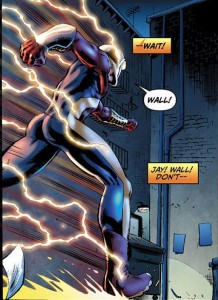
As I said above, it’s certainly the updated takes on beloved characters that makes this Earth 2 reboot both entertaining as well as interesting. Characters like Alan Scott, Jay Garrick, and Al Pratt are all reintroduced to a new audience who might not realize that they were the first characters to ever respectively don the identities of Green Lantern, The Flash, and The Atom. These are characters who have decades of history but aren’t attached to that continuity because of the New 52 relaunch. As such, they’re all freshened up for the modern era with relevant but progressive changes being made to the characters. For example, Alan Scott is now a gay, successful businessman on the cusp of potentially relocating with his lover Sam. Al Pratt is a commando badass who is part of a secret government project and Jay Garrick is a far departure from the usual golden oldie speedster he’s known for being, instead becoming a hip youngster who is grappling with the ever changing landscape of young adulthood. These small and large fundamental changes to the characters help to serve as the catalyst for some important storytelling decisions, all still tying back to be key characteristics associated with who the character is or what they’re going to become.
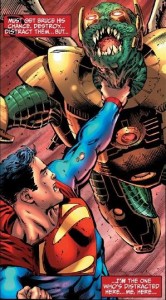
I’d like to take a second to highlight how important of a decision it was on behalf of Robinson to roll with characters like Scott, Garrick and Pratt instead of more prominently known characters. The entire idea of the New 52 was to try to hook in new readers and in using these sort of characters James Robinson provides people with minimal comic knowledge a chance to grow with characters who don’t necessarily have too large of a cult following. When someone says the name Green Lantern or The Flash or The Atom and begins talking about their civilian identities, people automatically think of the most prominent people to undertake those identities. The most popular Green Lantern is hands down Hal Jordan but he isn’t the first character to ever be a Green Lantern, likewise with Barry Allen as The Flash or Ray Palmer as The Atom. Instead these characters like Hal, Barry, and Ray are just the versions of those characters who the already established audience has connected with. In using characters that would be lesser known to a newer fan base, Robinson not only gives a new layer of reading to past readers but he also is provided an opportunity to make fundamental changes to these characters that are less likely to illicit unpopular opinions.
The first volume of Earth 2 is far more interested in building up its new heroes than it is for creating villains. The world building that Robinson does allows room for villains to be easily established in the large scope of things but still allows for breathing room to create smaller scale villains. These lower tier villains serve as a sizable threat for the new, unorganized heroes and give them a solid launching pad for gained experience instead of just being thrown into the deep end against a seemingly insurmountable task. Doing things this way is simple character development as Robinson gives the characters a villain who would be easily defeated if the heroes had a better handling on their powers and worked as a more cohesive unit. Robinson introduces a fairly standard Solomon Grundy as the main threat through the first arc to test the characters and bring them together but never really challenge them. Nonetheless, the threat still does feel real as Grundy is set up with a strong power set that threatens life on Earth 2. But still make no mistake that Grundy is technically a pushover here as Robinson still crafts an intelligent and different way of dealing with the character.
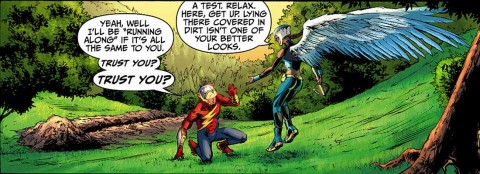
Collects: Earth 2 #1-6.
Best Character: Jay Garrick.
Best Line Of Dialogue/Caption: “…I was just checking I came off as sincere…and not a raving ego maniac in love with the sound of his own voice.” – Alan Scott.
Best Scene/Moment: Jay Garrick becomes The Flash – Issue 2.
Best Issue: Issue 4. The fourth issue of this collection introduces us to The Atom and is an action packed tour-de-force. Here you see all the new “wonders” uniting for the first time against their common foe, Solomon Grundy. This issue establishes Solomon Grundy as a threat to the Earth and begins to seed in some future plotlines as well, all while being just a kick-ass issue.
Why You Should Read It: What makes Earth 2 an important book to read is the fact that it still keeps the great Golden Age heroes of DC’s years gone bye relevant. That’s not to say characters like Alan Scott or Jay Garrick were irrelevant in the modern DC Universe because they were and played important roles in stories from several years ago. The more important fact is that updating these prestigious characters for the modern era of comics exposes them to all new readers. It’s incredibly important for new readers to show interest in these older characters and it’s even better when they show interest in these older characters in a modernized style as that’s what keeps comics published and fun. These new takes on old characters by James Robinson are vital for new and older generations of readers.
Justice League: Cry For Justice
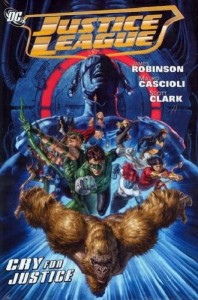 A few years before The New 52 initiative launched over at DC, James Robinson sought to tackle the Justice League in a different way. He sought to expose the difference between a league that feels like a family versus a team that truly seeks out justice. Shortly after the DC event “Final Crisis”, the League experienced a minor schism, wherein Hal Jordan wanted to seek true justice against villains as a result of the deaths of Batman and Martian Manhunter. Robinson would team with Marcus Cascioli and Scott Clark to bring to life a rather dark tale about seeking justice and the repercussions of the actions taken to seek justice.
A few years before The New 52 initiative launched over at DC, James Robinson sought to tackle the Justice League in a different way. He sought to expose the difference between a league that feels like a family versus a team that truly seeks out justice. Shortly after the DC event “Final Crisis”, the League experienced a minor schism, wherein Hal Jordan wanted to seek true justice against villains as a result of the deaths of Batman and Martian Manhunter. Robinson would team with Marcus Cascioli and Scott Clark to bring to life a rather dark tale about seeking justice and the repercussions of the actions taken to seek justice.
Following the sudden and unexpected death of two key members of the Justice League, Batman and Martian Manhunter, several heroes begin to question where the line blurs in regards to what they let villains get away with. Green Lantern and Green Arrow begin to object to the reactionary nature of the Justice League and gain the desire to take justice into their own hands. They unknowingly tackle a large undertaking that gains the support of several other heroes who have also recently lost people close to them as the result of villainous deeds. As Green Lantern assembles a squad of heroes willing to do what it takes to achieve justice, the new team begins to uncover a dark plot that threatens to push all the heroes into foreign territory as they grapple with tough moral decisions. Is murder justified if it achieves a feeling of justice?
James Robinson tells one of the darkest stories you’ll ever find the Justice League partake in with Justice League: Cry For Justice. Although dark, there’s no disputing how thoroughly enjoyable this tale is as you watch Robinson ask the hard hitting question of why superheroes always react instead of taking action. Stretching across seven issues, this miniseries takes several of everyone’s favourite DC characters, and even some obscure ones, and puts them through a gauntlet of villains and morally grey areas. At first the series seems to have a rather slow burning nature to it, taking its time to establish the characters and the direction the plot desires to move in. It’s a fair statement to say that much of the first three issues are like a chess game, moving all the pieces around the board before inevitably paying off during the last four issues. From issue four onward it is all unexpected twists and turns that are sure to shock readers with Robinson piling on plenty of moments that you won’t see coming whatsoever. The nature of these moments will leave the reader unsettled as they are truly story beats you wouldn’t expect coming based off the pacing of the first three issues.
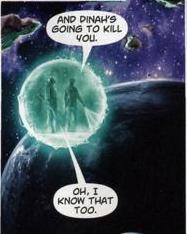 Cry For Justice starts off with a wave of emotional reactions by Hal Jordan, The Green Lantern, as he argues with the Justice League about why they let villains take the first strike against them constantly instead of just hunting down the villains first and putting them away quickly. This creates an incredibly distinct divide between the members of the team as initially it is only Green Lantern and Green Arrow who think that tracking down the villains is the way to go and even then Green Arrow seemingly takes on the task more out of loyalty to his longtime friend than anything else. The cast that gets built around these two heroes is a rather interesting subsidiary team of the Justice League that has strong enough characters that it could justify itself as an ongoing series. There are a few characters who pop up amongst the cast like Starman and Congo Bill who just feel wildly unnecessary as it’s hard at first glance to see what they really contribute to the story overall. Their story isn’t uninteresting, it’s just one or two steps away from what’s already happening under Green Lantern’s guidance and ultimately feels like the two characters could’ve just been lobbed into the group of characters from the first issue and cut out some scenes that didn’t add anything to the plot. On the flip side of this, Robinson throws characters like Jay Garrick, The Shade, The Atom and many others who he uses quite well to serve a purpose in the plot. Even if their scenes hold some brevity, they still contribute something towards pushing the narrative forward to the satisfying conclusion of this story.
Cry For Justice starts off with a wave of emotional reactions by Hal Jordan, The Green Lantern, as he argues with the Justice League about why they let villains take the first strike against them constantly instead of just hunting down the villains first and putting them away quickly. This creates an incredibly distinct divide between the members of the team as initially it is only Green Lantern and Green Arrow who think that tracking down the villains is the way to go and even then Green Arrow seemingly takes on the task more out of loyalty to his longtime friend than anything else. The cast that gets built around these two heroes is a rather interesting subsidiary team of the Justice League that has strong enough characters that it could justify itself as an ongoing series. There are a few characters who pop up amongst the cast like Starman and Congo Bill who just feel wildly unnecessary as it’s hard at first glance to see what they really contribute to the story overall. Their story isn’t uninteresting, it’s just one or two steps away from what’s already happening under Green Lantern’s guidance and ultimately feels like the two characters could’ve just been lobbed into the group of characters from the first issue and cut out some scenes that didn’t add anything to the plot. On the flip side of this, Robinson throws characters like Jay Garrick, The Shade, The Atom and many others who he uses quite well to serve a purpose in the plot. Even if their scenes hold some brevity, they still contribute something towards pushing the narrative forward to the satisfying conclusion of this story.
Green Arrow’s character, and more precisely his liberal nature, is hugely important as it conflicts with his views in this story, specifically during the resolution where the choices he needs to make directly contrast with having a liberal mindset. This is one of the best parts of the entire storyline as you see Ollie, after every brutal thing he’s endured throughout, have to make an incredibly difficult decision that ends the story with a true bang. As the dust settles you can’t help but cheer for Ollie and the decision he makes but then you realize that you’re cheering for the wrong reasons. It’s brilliant work on Robinson’s behalf as he makes you question your own beliefs through having these characters question and compromise their own beliefs. At the end of the day, it’s exactly what any writer should strive for with their writing, to illicit some form of emotional reaction through their body of work.

Collects: Justice League Cry For Justice #1-7, Faces Of Evil: Prometheus #1, and Secret Origins for multiple characters.
Best Character: Green Arrow
Best Line Of Dialogue/Caption: “–I can’t feel my fingers.” – *Redacted to avoid spoilers*
Best Scene/Moment: The brutal cliffhanger ending – Issue 5
Best Issue: Issue 6 – The Game. Fittingly titled “The Game”, you watched as Prometheus systematically cuts his way through just about every member of the Justice League available, full-time or reserve. It’s a highly entertaining climax to the miniseries that shows you how brilliantly James Robinson writes the rather simple villain, using him to a highly entertaining degree. As a reader, there is just something fascinating about watching villains dissect the heroes and their methods to the point where they are utterly useless. It heightens the drama as you watch Prometheus’ master plan get revealed and the issue ends in yet another startling cliffhanger.
Why You Should Read It: The moral dilemmas faced by many of the characters in this volume are real life problems and understandably easy to relate to. Robinson just taps into an obvious superhero dilemma and uses it to drive this whole series forward into a dark, disturbing tale. This is a good Justice League story that ends up being an even better Green Arrow story when you really look at all the shades present and what the character goes through.


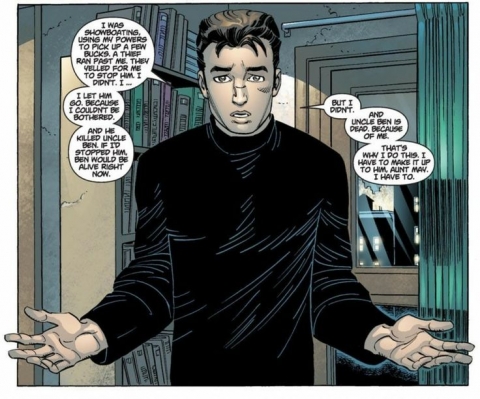
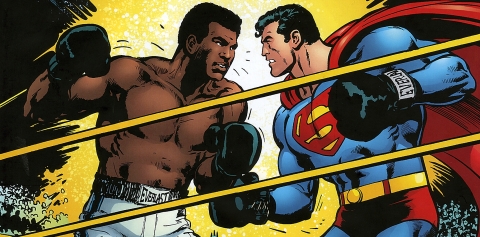
I recall reading the Robinson issues of the Justice League and wondering if he was experimenting with his character dialogue. It was almost as if this should have been a novel and the artwork just got in the way. Continue being a huge fan of his work, but this run just didn’t work for me.